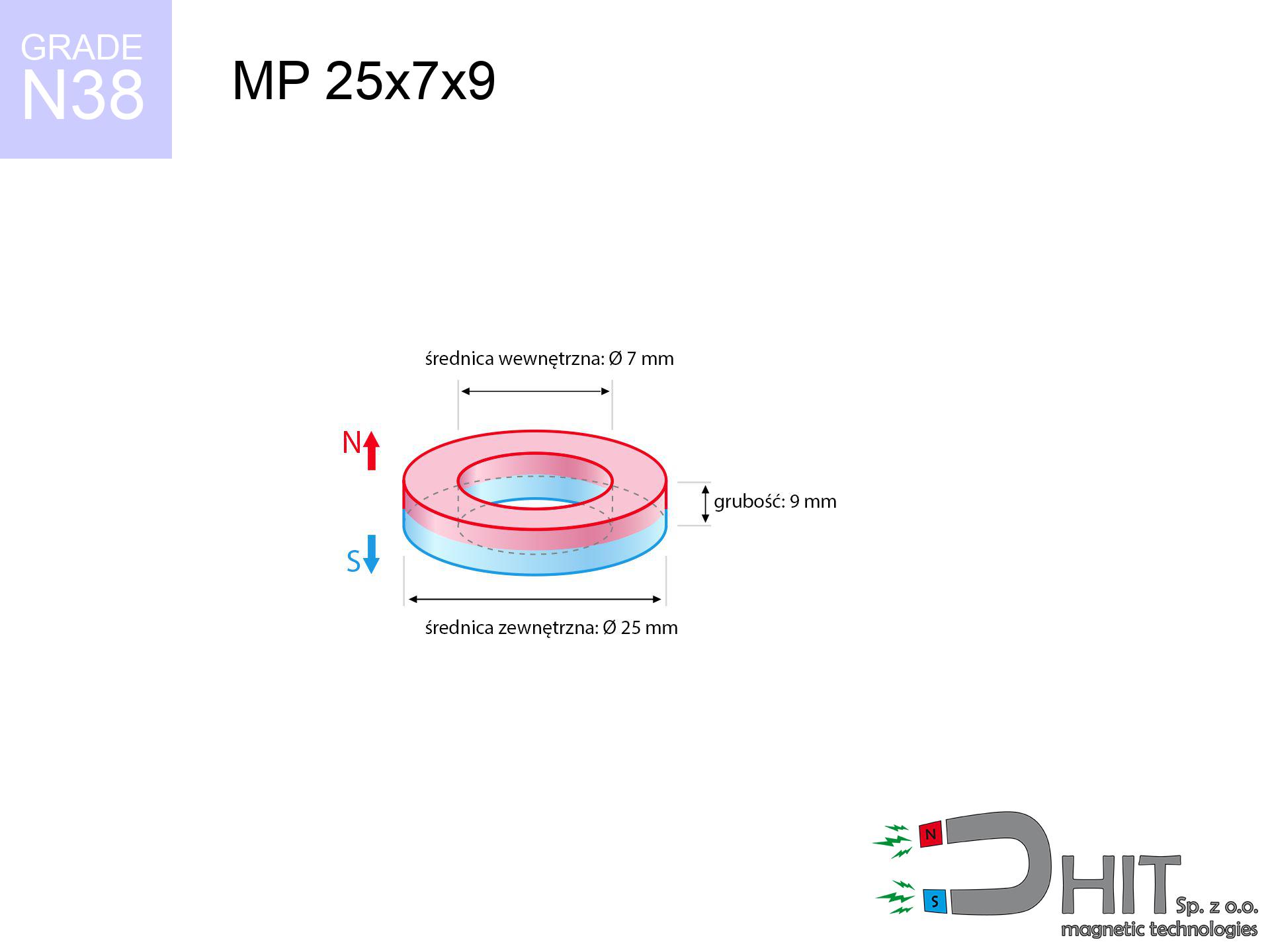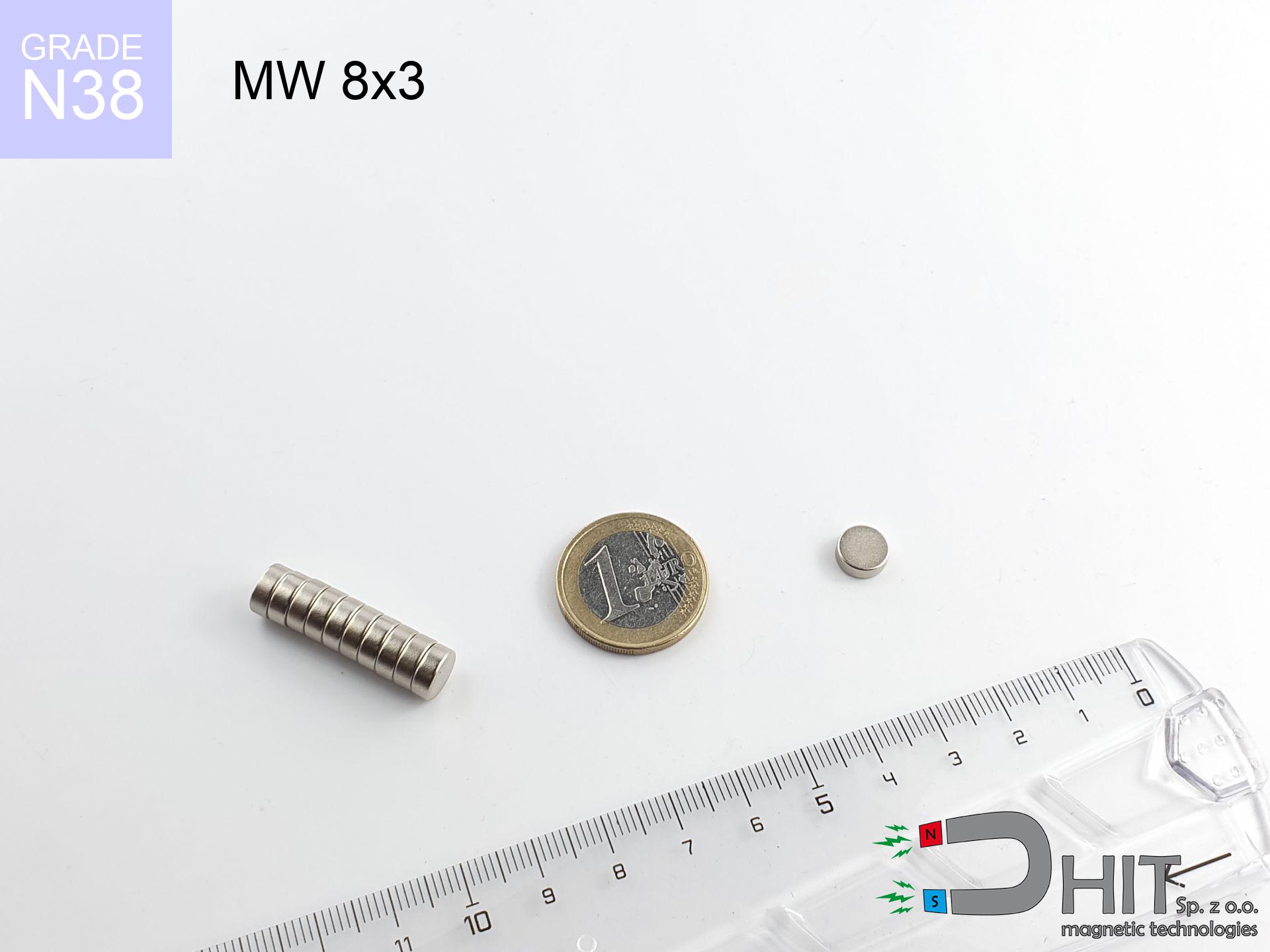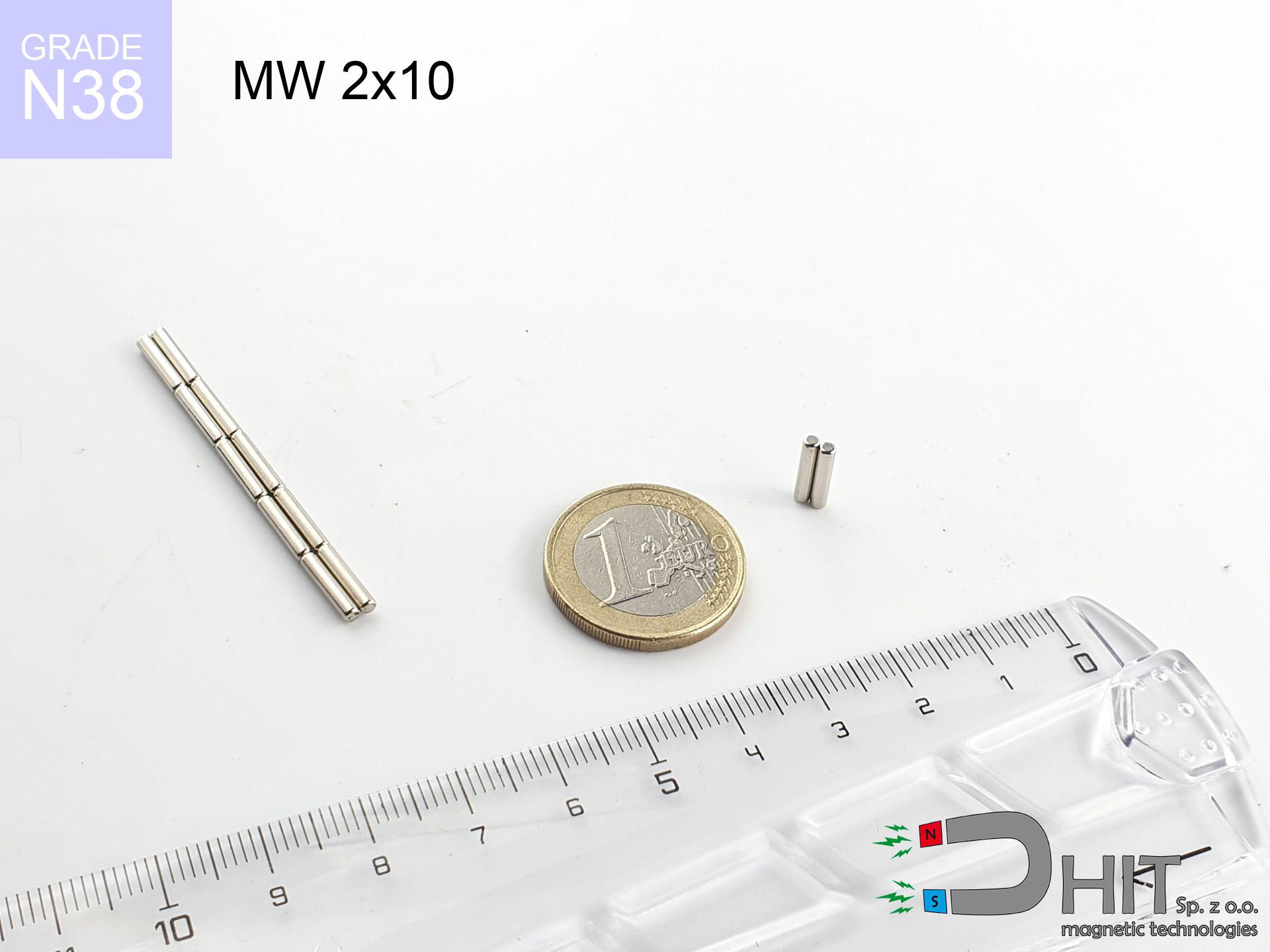MP 25x7x9 / N38 - ring magnet
ring magnet
Catalog no 030195
GTIN: 5906301812128
Diameter
25 mm [±0,1 mm]
internal diameter Ø
7 mm [±0,1 mm]
Height
9 mm [±0,1 mm]
Weight
30.54 g
Magnetization Direction
↑ axial
Load capacity
14.82 kg / 145.39 N
Magnetic Induction
362.13 mT / 3621 Gs
Coating
[NiCuNi] Nickel
12.55 ZŁ with VAT / pcs + price for transport
10.20 ZŁ net + 23% VAT / pcs
bulk discounts:
Need more?Want to negotiate?
Pick up the phone and ask
+48 22 499 98 98
or let us know via
form
the contact page.
Weight as well as shape of neodymium magnets can be analyzed on our
magnetic calculator.
Orders submitted before 14:00 will be dispatched today!
MP 25x7x9 / N38 - ring magnet
Specification / characteristics MP 25x7x9 / N38 - ring magnet
| properties | values |
|---|---|
| Cat. no. | 030195 |
| GTIN | 5906301812128 |
| Production/Distribution | Dhit sp. z o.o. |
| Country of origin | Poland / China / Germany |
| Customs code | 85059029 |
| Diameter | 25 mm [±0,1 mm] |
| internal diameter Ø | 7 mm [±0,1 mm] |
| Height | 9 mm [±0,1 mm] |
| Weight | 30.54 g |
| Magnetization Direction | ↑ axial |
| Load capacity ~ ? | 14.82 kg / 145.39 N |
| Magnetic Induction ~ ? | 362.13 mT / 3621 Gs |
| Coating | [NiCuNi] Nickel |
| Manufacturing Tolerance | ±0.1 mm |
Magnetic properties of material N38
| properties | values | units |
|---|---|---|
| remenance Br [Min. - Max.] ? | 12.2-12.6 | kGs |
| remenance Br [Min. - Max.] ? | 1220-1260 | T |
| coercivity bHc ? | 10.8-11.5 | kOe |
| coercivity bHc ? | 860-915 | kA/m |
| actual internal force iHc | ≥ 12 | kOe |
| actual internal force iHc | ≥ 955 | kA/m |
| energy density [Min. - Max.] ? | 36-38 | BH max MGOe |
| energy density [Min. - Max.] ? | 287-303 | BH max KJ/m |
| max. temperature ? | ≤ 80 | °C |
Physical properties of sintered neodymium magnets Nd2Fe14B at 20°C
| properties | values | units |
|---|---|---|
| Vickers hardness | ≥550 | Hv |
| Density | ≥7.4 | g/cm3 |
| Curie Temperature TC | 312 - 380 | °C |
| Curie Temperature TF | 593 - 716 | °F |
| Specific resistance | 150 | μΩ⋅Cm |
| Bending strength | 250 | Mpa |
| Compressive strength | 1000~1100 | Mpa |
| Thermal expansion parallel (∥) to orientation (M) | (3-4) x 106 | °C-1 |
| Thermal expansion perpendicular (⊥) to orientation (M) | -(1-3) x 10-6 | °C-1 |
| Young's modulus | 1.7 x 104 | kg/mm² |
Physical simulation of the magnet - technical parameters
The following values constitute the result of a mathematical simulation. Values are based on algorithms for the class Nd2Fe14B. Operational conditions might slightly deviate from the simulation results. Please consider these data as a reference point during assembly planning.
MP 25x7x9 / N38
| Distance (mm) | Induction (Gauss) / mT | Pull Force (kg) | Risk Status |
|---|---|---|---|
| 0 mm |
5777 Gs
577.7 mT
|
14.82 kg / 14820.0 g
145.4 N
|
critical level |
| 1 mm |
5310 Gs
531.0 mT
|
12.52 kg / 12519.6 g
122.8 N
|
critical level |
| 2 mm |
4846 Gs
484.6 mT
|
10.43 kg / 10425.5 g
102.3 N
|
critical level |
| 3 mm |
4397 Gs
439.7 mT
|
8.59 kg / 8586.1 g
84.2 N
|
strong |
| 5 mm |
3576 Gs
357.6 mT
|
5.68 kg / 5678.0 g
55.7 N
|
strong |
| 10 mm |
2073 Gs
207.3 mT
|
1.91 kg / 1907.5 g
18.7 N
|
safe |
| 15 mm |
1231 Gs
123.1 mT
|
0.67 kg / 673.1 g
6.6 N
|
safe |
| 20 mm |
773 Gs
77.3 mT
|
0.27 kg / 265.0 g
2.6 N
|
safe |
| 30 mm |
356 Gs
35.6 mT
|
0.06 kg / 56.2 g
0.6 N
|
safe |
| 50 mm |
115 Gs
11.5 mT
|
0.01 kg / 5.9 g
0.1 N
|
safe |
MP 25x7x9 / N38
| Distance (mm) | Friction coefficient | Pull Force (kg) |
|---|---|---|
| 0 mm | Stal (~0.2) |
2.96 kg / 2964.0 g
29.1 N
|
| 1 mm | Stal (~0.2) |
2.50 kg / 2504.0 g
24.6 N
|
| 2 mm | Stal (~0.2) |
2.09 kg / 2086.0 g
20.5 N
|
| 3 mm | Stal (~0.2) |
1.72 kg / 1718.0 g
16.9 N
|
| 5 mm | Stal (~0.2) |
1.14 kg / 1136.0 g
11.1 N
|
| 10 mm | Stal (~0.2) |
0.38 kg / 382.0 g
3.7 N
|
| 15 mm | Stal (~0.2) |
0.13 kg / 134.0 g
1.3 N
|
| 20 mm | Stal (~0.2) |
0.05 kg / 54.0 g
0.5 N
|
| 30 mm | Stal (~0.2) |
0.01 kg / 12.0 g
0.1 N
|
| 50 mm | Stal (~0.2) |
0.00 kg / 2.0 g
0.0 N
|
MP 25x7x9 / N38
| Surface type | Friction coefficient / % Mocy | Max load (kg) |
|---|---|---|
| Raw steel |
µ = 0.3
30% Nominalnej Siły
|
4.45 kg / 4446.0 g
43.6 N
|
| Painted steel (standard) |
µ = 0.2
20% Nominalnej Siły
|
2.96 kg / 2964.0 g
29.1 N
|
| Oily/slippery steel |
µ = 0.1
10% Nominalnej Siły
|
1.48 kg / 1482.0 g
14.5 N
|
| Magnet with anti-slip rubber |
µ = 0.5
50% Nominalnej Siły
|
7.41 kg / 7410.0 g
72.7 N
|
MP 25x7x9 / N38
| Steel thickness (mm) | % power | Real pull force (kg) |
|---|---|---|
| 0.5 mm |
|
0.74 kg / 741.0 g
7.3 N
|
| 1 mm |
|
1.85 kg / 1852.5 g
18.2 N
|
| 2 mm |
|
3.71 kg / 3705.0 g
36.3 N
|
| 5 mm |
|
9.26 kg / 9262.5 g
90.9 N
|
| 10 mm |
|
14.82 kg / 14820.0 g
145.4 N
|
MP 25x7x9 / N38
| Ambient temp. (°C) | Power loss | Remaining pull | Status |
|---|---|---|---|
| 20 °C | 0.0% |
14.82 kg / 14820.0 g
145.4 N
|
OK |
| 40 °C | -2.2% |
14.49 kg / 14494.0 g
142.2 N
|
OK |
| 60 °C | -4.4% |
14.17 kg / 14167.9 g
139.0 N
|
OK |
| 80 °C | -6.6% |
13.84 kg / 13841.9 g
135.8 N
|
|
| 100 °C | -28.8% |
10.55 kg / 10551.8 g
103.5 N
|
MP 25x7x9 / N38
| Gap (mm) | Attraction (kg) (N-S) | Repulsion (kg) (N-N) |
|---|---|---|
| 0 mm |
74.73 kg / 74732 g
733.1 N
6 082 Gs
|
N/A |
| 1 mm |
68.86 kg / 68859 g
675.5 N
11 091 Gs
|
61.97 kg / 61973 g
608.0 N
~0 Gs
|
| 2 mm |
63.13 kg / 63132 g
619.3 N
10 620 Gs
|
56.82 kg / 56819 g
557.4 N
~0 Gs
|
| 3 mm |
57.70 kg / 57697 g
566.0 N
10 153 Gs
|
51.93 kg / 51927 g
509.4 N
~0 Gs
|
| 5 mm |
47.77 kg / 47770 g
468.6 N
9 238 Gs
|
42.99 kg / 42993 g
421.8 N
~0 Gs
|
| 10 mm |
28.63 kg / 28632 g
280.9 N
7 152 Gs
|
25.77 kg / 25769 g
252.8 N
~0 Gs
|
| 20 mm |
9.62 kg / 9619 g
94.4 N
4 145 Gs
|
8.66 kg / 8657 g
84.9 N
~0 Gs
|
| 50 mm |
0.59 kg / 587 g
5.8 N
1 024 Gs
|
0.53 kg / 528 g
5.2 N
~0 Gs
|
MP 25x7x9 / N38
| Object / Device | Limit (Gauss) / mT | Safe distance |
|---|---|---|
| Pacemaker | 5 Gs (0.5 mT) | 17.0 cm |
| Hearing aid | 10 Gs (1.0 mT) | 13.5 cm |
| Timepiece | 20 Gs (2.0 mT) | 10.5 cm |
| Mobile device | 40 Gs (4.0 mT) | 8.0 cm |
| Remote | 50 Gs (5.0 mT) | 7.5 cm |
| Payment card | 400 Gs (40.0 mT) | 3.0 cm |
| HDD hard drive | 600 Gs (60.0 mT) | 2.5 cm |
MP 25x7x9 / N38
| Start from (mm) | Speed (km/h) | Energy (J) | Predicted outcome |
|---|---|---|---|
| 10 mm |
23.94 km/h
(6.65 m/s)
|
0.68 J | |
| 30 mm |
38.57 km/h
(10.71 m/s)
|
1.75 J | |
| 50 mm |
49.69 km/h
(13.80 m/s)
|
2.91 J | |
| 100 mm |
70.25 km/h
(19.52 m/s)
|
5.82 J |
MP 25x7x9 / N38
| Technical parameter | Value / Description |
|---|---|
| Coating type | [NiCuNi] Nickel |
| Layer structure | Nickel - Copper - Nickel |
| Layer thickness | 10-20 µm |
| Salt spray test (SST) ? | 24 h |
| Recommended environment | Indoors only (dry) |
MP 25x7x9 / N38
| Parameter | Value | Jedn. SI / Opis |
|---|---|---|
| Strumień (Flux) | 22 495 Mx | 225.0 µWb |
| Współczynnik Pc | 1.05 | Wysoki (Stabilny) |
MP 25x7x9 / N38
| Environment | Effective steel pull | Effect |
|---|---|---|
| Air (land) | 14.82 kg | Standard |
| Water (riverbed) |
16.97 kg
(+2.15 kg Buoyancy gain)
|
+14.5% |
1. Shear force
*Warning: On a vertical surface, the magnet retains merely approx. 20-30% of its nominal pull.
2. Efficiency vs thickness
*Thin steel (e.g. computer case) drastically weakens the holding force.
3. Temperature resistance
*For N38 material, the critical limit is 80°C.
Check out also offers
Pros and cons of rare earth magnets.
Advantages
- They do not lose magnetism, even after around 10 years – the decrease in strength is only ~1% (based on measurements),
- Neodymium magnets remain extremely resistant to magnetic field loss caused by magnetic disturbances,
- In other words, due to the metallic surface of nickel, the element becomes visually attractive,
- They feature high magnetic induction at the operating surface, which increases their power,
- Due to their durability and thermal resistance, neodymium magnets can operate (depending on the form) even at high temperatures reaching 230°C or more...
- In view of the possibility of free molding and customization to custom needs, magnetic components can be produced in a broad palette of shapes and sizes, which expands the range of possible applications,
- Versatile presence in modern industrial fields – they find application in data components, electric motors, advanced medical instruments, also modern systems.
- Compactness – despite small sizes they offer powerful magnetic field, making them ideal for precision applications
Disadvantages
- At very strong impacts they can crack, therefore we advise placing them in steel cases. A metal housing provides additional protection against damage and increases the magnet's durability.
- When exposed to high temperature, neodymium magnets suffer a drop in force. Often, when the temperature exceeds 80°C, their strength decreases (depending on the size, as well as shape of the magnet). For those who need magnets for extreme conditions, we offer [AH] versions withstanding up to 230°C
- When exposed to humidity, magnets usually rust. To use them in conditions outside, it is recommended to use protective magnets, such as magnets in rubber or plastics, which secure oxidation and corrosion.
- Limited ability of making nuts in the magnet and complicated shapes - preferred is a housing - magnet mounting.
- Possible danger related to microscopic parts of magnets are risky, when accidentally swallowed, which is particularly important in the aspect of protecting the youngest. Additionally, small elements of these devices can complicate diagnosis medical when they are in the body.
- Higher cost of purchase is one of the disadvantages compared to ceramic magnets, especially in budget applications
Holding force characteristics
Maximum lifting capacity of the magnet – what it depends on?
- using a sheet made of mild steel, serving as a magnetic yoke
- whose transverse dimension is min. 10 mm
- with an polished contact surface
- under conditions of no distance (surface-to-surface)
- during detachment in a direction perpendicular to the plane
- in temp. approx. 20°C
Determinants of practical lifting force of a magnet
- Gap (betwixt the magnet and the metal), since even a tiny distance (e.g. 0.5 mm) leads to a reduction in force by up to 50% (this also applies to paint, rust or dirt).
- Force direction – catalog parameter refers to pulling vertically. When slipping, the magnet holds much less (often approx. 20-30% of nominal force).
- Wall thickness – thin material does not allow full use of the magnet. Part of the magnetic field passes through the material instead of converting into lifting capacity.
- Steel grade – ideal substrate is pure iron steel. Hardened steels may generate lower lifting capacity.
- Surface condition – ground elements ensure maximum contact, which improves force. Rough surfaces weaken the grip.
- Temperature – heating the magnet results in weakening of force. Check the thermal limit for a given model.
Holding force was tested on a smooth steel plate of 20 mm thickness, when the force acted perpendicularly, however under attempts to slide the magnet the holding force is lower. Moreover, even a small distance between the magnet and the plate decreases the holding force.
Implant safety
Patients with a heart stimulator must keep an absolute distance from magnets. The magnetic field can stop the functioning of the life-saving device.
Bodily injuries
Protect your hands. Two powerful magnets will join immediately with a force of massive weight, crushing anything in their path. Be careful!
Immense force
Be careful. Neodymium magnets attract from a long distance and connect with massive power, often quicker than you can react.
Cards and drives
Avoid bringing magnets close to a wallet, computer, or TV. The magnetism can destroy these devices and erase data from cards.
GPS and phone interference
GPS units and mobile phones are highly sensitive to magnetic fields. Direct contact with a powerful NdFeB magnet can decalibrate the internal compass in your phone.
Fire warning
Mechanical processing of NdFeB material carries a risk of fire risk. Neodymium dust oxidizes rapidly with oxygen and is hard to extinguish.
Nickel allergy
Nickel alert: The nickel-copper-nickel coating contains nickel. If redness occurs, cease working with magnets and use protective gear.
Thermal limits
Keep cool. NdFeB magnets are susceptible to heat. If you require resistance above 80°C, ask us about HT versions (H, SH, UH).
Product not for children
These products are not toys. Accidental ingestion of multiple magnets may result in them connecting inside the digestive tract, which poses a severe health hazard and requires immediate surgery.
Magnet fragility
Watch out for shards. Magnets can fracture upon uncontrolled impact, ejecting sharp fragments into the air. Eye protection is mandatory.




![SM 25x100 [2xM8] / N42 - magnetic separator SM 25x100 [2xM8] / N42 - magnetic separator](https://cdn3.dhit.pl/graphics/products/sm-25x100-2xm8-feg.jpg)




